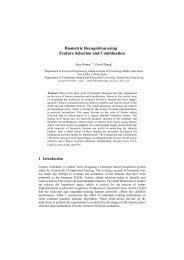LNCS/LNAI Authors' Instructions
LNCS/LNAI Authors' Instructions
LNCS/LNAI Authors' Instructions
You also want an ePaper? Increase the reach of your titles
YUMPU automatically turns print PDFs into web optimized ePapers that Google loves.
2 Alfred Hofmann et al.<br />
2Manuscript Preparation<br />
You are strongly encouraged to use L ATEX2ε for the preparation of your cameraready<br />
manuscript together with the corresponding Springer class file llncs.cls;<br />
see Sect. 3. Only if you use L ATEX2ε can hyperlinks be generated in the online<br />
version of your manuscript.<br />
If you are unable to use L ATEX, you may use MS Word together with the<br />
template sv-lncs.dot (see Sect. 4) or any other text processing system. In the<br />
latter case, please follow these instructions closely in order to make the volume<br />
look as uniform as possible.<br />
We would like to stress that the class/style files and the template should not<br />
be manipulated and that the guidelines regarding font sizes and format should<br />
be adhered to. This is to ensure that the end product is as homogeneous as<br />
possible.<br />
2.1 Printing Area<br />
The printing area is 122 mm × 193 mm. The text should be justified to occupy<br />
the full line width, so that the right margin is not ragged, with words hyphenated<br />
as appropriate. Please fill pages so that the length of the text is no less than<br />
180 mm.<br />
2.2 Layout, Typeface, Font Sizes, and Numbering<br />
Use 10-point type for the name(s) of the author(s) and 9-point type for the<br />
address(es) and the abstract. For the main text, please use 10-point type and<br />
single-line spacing. We recommend using Computer Modern Roman (CM) fonts,<br />
Times, or one of the similar typefaces widely used in photo-typesetting. (In these<br />
typefaces the letters have serifs, i.e., short endstrokes at the head and the foot<br />
of letters.) Italic type may be used to emphasize words in running text. Bold<br />
type and underlining should be avoided. With these sizes, the interline distance<br />
should be set so that some 45 lines occur on a full-text page.<br />
Headings. Headings should be capitalized (i.e., nouns, verbs, and all other<br />
words except articles, prepositions, and conjunctions should be set with an initial<br />
capital) and should, with the exception of the title, be aligned to the left. Words<br />
joined by a hyphen are subject to a special rule. If the first word can stand alone,<br />
the second word should be capitalized. The font sizes are given in Table 1.<br />
Here are some examples of headings: “Criteria to Disprove Context-Freeness<br />
of Collage Languages”, “On Correcting the Intrusion of Tracing Non-deterministic<br />
Programs by Software”, “A User-Friendly and Extendable Data Distribution<br />
System”, “Multi-flip Networks: Parallelizing GenSAT”, “Self-determinations of<br />
Man”.




